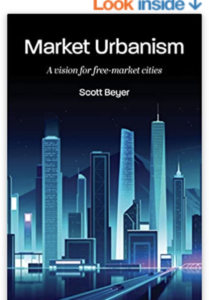Housing and Urban Development
Choice two for the Stoa league this year is: Resolved: Housing and urban development policy should be substantially reformed in the United States. The brief discussion on the Stoa Spring Vote 2022 page notes the resolution is:
Intentionally designed to leave the actor up to the students, this resolution allows debaters to explore how federal, state, and local policies are impacting housing supply, skyrocketing costs, homelessness, and other important urban development issues.
So the topic concerns housing in urban areas, excluding suburban and rural areas. (note: maybe I am wrong about this. Maybe “housing” policy is to be considered in addition to urban development policy, rather than housing just in urban areas?)
Housing and urban development policies in the United States have a fascinating history. Critics of current housing and urban development focus on regulatory barriers that raise the cost of new housing. One example in San Francisco Man Has Spent 4 Years and $1 Million Trying to Get Approval to Turn His Own Laundromat Into an Apartment Building (Reason, February 21, 2018):
To understand how difficult and expensive it is to build housing in San Francisco, observe the case of Robert Tillman. Tillman owns a single-story laundromat in the city’s Mission District. Since 2014, he has been attempting to develop his property into a 75-unit apartment building.
The city is in the midst of a housing affordability crisis, with an average one-bedroom apartment going for $3,400 a month. So you might think Tillman’s project would sail through the permitting process. Instead, the city’s labyrinthine process of reviews, regulations, and appeals has dragged on for four years. The project has cost the self-described “accidental developer” nearly $1 million so far, and he hasn’t even broken ground yet.
The Manhattan Institute’s Urban Policy Series provides an in-depth look at urban development issues and challenges.
Land use regulations raise housing costs in suburban as well as urban areas. See Density or Sprawl? How To Solve the Urban Housing Crisis (Reason, February 28, 2020):
In the U.S., cities have become remarkably expensive because housing prices have outpaced wage growth. Developers don’t build enough new supply to meet rising demand because a thicket of regulations artificially drive up building costs.
Is the solution more density in the core or more sprawl in the periphery—or both? If governments were to remove the artificial restrictions and incentives that shape the landscape of American cities, how would urban dwellers choose to live?
“There is a huge pent up demand for density and for urban living that simply is not being able to get met because of the restrictive zoning,” says urban policy analyst Scott Beyer, founder of The Market Urbanism Report, which promotes market-based solutions to urban planning issues.

More from the Market Urbanism Report here. Also see: Market Urbanism: A vision for free-market cities Kindle Edition (January 2022). Also see the Market Urbanism Report on Facebook.
Housing and Homelessness (October 21, 2021) is an essay in the Project on Poverty and Inequality in California Final Report series.
For anyone who thinks urban housing has to be expensive because of high demand, consider this WSJ article: What Housing Crisis? In Japan, Home Prices Stay Flat: Supply keeps up with demand in Tokyo thanks to few restrictions on development (WSJ, April 2, 2019).
And for the related urban problem of homelessness, see the Independent Institute’s Beyond Homeless: Finding Hope documentary on San Francisco.
